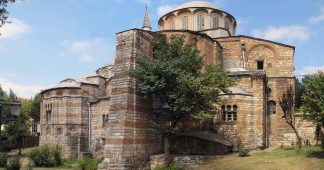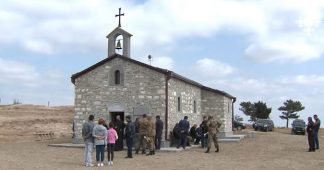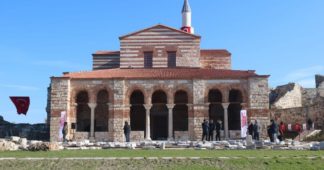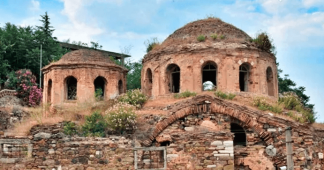Yet another historic church is violated and left to rot in Turkey. The decades-long victim of the abuse, the Surp Minas Church, located in the city Erzurum, is now caught in the middle of an urban transformation project. Furthermore, it has largely been destroyed by treasure hunters.
The history of this church is an example of the many violations and desecrations experienced by almost all of Turkey’s historic churches.
Built by Armenians in 1790, the Surp Minas church currently faces extinction. The church, which was used as a stable for years, has been targeted by the town’s municipality, Muslim locals, and treasure hunters, among others. The pictures on the interior walls of the church have been largely erased, its walls desecrated.
According to news reports, the church “passed into private ownership” following WWI, during which time the 1913-23 Christian genocide was being perpetrated by Ottoman Turkey.
“If we leave aside its architecture that is different from the other structures there, one thousand witnesses would be needed to call it a church,” the Turkish newspaper Erzurum Pusula said in 2017. “It is collapsing, completely uncared for and unprotected. This church has an interesting trait. It belongs to an individual.”
According to the report, a lawyer from Erzurum “bought” the church in 1934. After he died, the church was “inherited” by his descendants. The church was then used by drunk people in the summer and functioned as a stable during the winter.
The mayor at the time, Muhammet Cevdet Orhan, wanted to either turn the “deserted, unused” church into a mosque or restore it, claimed the newspaper. The report concluded by saying that “the church has caused such trouble for the mayor.”
In 2019, another Turkish newspaper, Evrensel, reported that the church was impacted by the garbage and rubble heaps which the municipality poured into the area.
The current “heirs” to the church are Sabri Ergin, who lives in Germany, and his sister, Professor Ceyda Ergin. The newspaper Agos conducted an interview with Sabri Ergin in 2016. Ergin said that he inherited the Surp Minas church from his mother, who had inherited the piece of land from his father on which the church is located. “The church cannot be used right now as there are no more congregants there,” said Ergin. He continued:
“When I went to the Armenian patriarchate, someone there told me to give the church to him. We are not distributing property here. Also, some other people wanted to buy it. They told me that some other church was sold for 1.5 million dollars but I did not sell the church.”
Ergin added that the municipality had threatened him twice with destroying the church. He said, “They told me they would destroy the church if I did not get it restored in a week. So I got the church registered as a historical monument in 2010.” But in 2016, the municipality contacted Ergin again and told him they wanted the church to be destroyed. Ergin said that he would take the case to the European Court of Human Rights (ECHR) if the church, which now had the status of a historical monument, was destroyed.
Ergin added that he prepared a project to restore the church in 2012, but he could not provide the required finance: “When we prepared the project, the budget turned out to be about 500 thousand dollars. We want the church to host cultural and artistic activities… If there were even a small Armenian congregation there today, it would be much easier.”
In a recent interview with Agos, Ergin said the local municipality wanted to change the name and location of the church.
“It was suggested by the municipality to rename the church ‘Mehlika Kobal Cultural Center’ in order to destroy the name ‘Surp Minas’, and the suggestion was rejected by me. In addition, the Mayor of Aziziye suggested that the Surp Minas Church be moved from its location to another place. He stated that this is a precious area and that the presence of the church here will prevent the development of this area. This was also rejected by me.”
The municipality informed Ergin that the municipal authorities aim to restore the church as a feature of the local tourism industry.
Apparently, according to Turkish authorities, a church in desperate need for restoration could operate as anything but a church.
Garo Paylan, an Armenian member of parliament from the opposition HDP (Peoples’ Democratic Party), has recently submitted a parliamentary question about the 231-year old church to the Minister of Culture and Tourism Mehmet Nuri Ersoy.
Paylan’s parliamentary proposal notes:
“The church is one of the most important historical and cultural structures in the region. However, it has for years been abandoned to its fate due to neglect and indifference, and has been attacked by vandals and treasure hunters.
“Although the church is a registered building protected by the Board of Monuments, the urban transformation activity around it has increased concerns about the damage to the building, which is having a hard time standing.”
Paylan presented the following questions to the minister:
- Why do you not protect Erzurum Surp Minas Armenian Church?
- Why have you remained silent about the urban transformation around the church in Erzurum?
- Have the treasure hunters targeting the church been identified and has legal action been taken against them?
- Why are the historical buildings belonging to Christians within the borders of Erzurum province not protected by the ministry?
- Has an inventory of monasteries, churches and cultural structures built by Christians in Erzurum been prepared?”
Unsurprisingly, the minister has not yet answered Paylan’s questions.
Erzurum is a city once inhabited by Armenian, Greek, and Assyrian Christians. The city today is predominantly Sunni-Muslim. This demographic shift is because during the 1913-23 Christian genocide committed by Ottoman Turkey, the city’s Christian population was eradicated.
From Karin/ Theodosiopolis to Erzurum
Erzurum, also known as Karin in Armenian, is a city located in the Armenian highland of eastern Turkey. According to the book “Armenian Karin/Erzerum,” edited by Professor Richard G. Hovannisian,
“The fortress city of Karin or Theodosiopolis, later called Erzerum, lay at the strategic center of the region known as Bardzr Hayk (Upper Armenia) and of the broader area of Greater Armenia itself. It has been the site of countless battles down through the centuries, as control of this highland is key to dominion over the entire Armenian Plateau. From the four gates of the once-walled city, roads radiated in all directions, taking merchants, travelers, and soldiers to and from Iran, the Caucasus, the Black Sea ports, and the interior neighboring cities and provinces. The plain of Karin/Erzerum, spreading to the north of the city, was dotted by numerous Armenian villages and several renowned monasteries lying near the headwaters of the Euphrates River. This to the Armenians was the ‘Bosom of the World’.”
The Eastern Roman (Byzantine) Empire reinforced the city, built a frontier fortress there, and renamed the city Theodosiopolis in honor of the Byzantine Emperor Theodosius II (reigned 408-450).
According to the International Dictionary of Historic Places: Southern Europe,
“Both the Arabs and the Turks knew Theodosiopolis as Arz-ar Rum, variously translated as ‘Land of the Romans,’ ‘Domain of the Byzantines,’ or ‘Frontier of Greece,’ from which its present name is derived.”
The Turks referred to Orthodox Christian communities in Anatolia as the “Roman community,” and labeled the people “Rum,” meaning Roman, a term which is used until this day.
The city was a continued target of Muslim armies such as the Arabs, the Persians, the Turkic tribes from the Central Asia, the Ottomans and the Turkish republic
Turkic armies from central Asia: New frontiersmen of Islam
“In the eleventh century, a new threat appeared from the east: a Turkoman clan led by Seljukid chieftains. The Turks originally emerged in central Asia in the seventh or eighth century, began migrating westward, and encountered the Arabs in the ninth century. The Arabs had converted the majority of Turks to Islam by the end of the tenth century, and recruited them as warriors. The appearance of the Seljuk Turks in Anatolia set the stage for the decline of Roman-Byzantine-Christian rule.
“The Seljuks began raiding Byzantine territory in 1045; a large force led by Ibrahim Inal sacked Theodosiopolis in 1048. Seljuk sultan Alp Arslan… decisively defeated the demoralized army of Byzantine emperor Romanus VI Diogenes in Manzikert (now Malazgirt), in eastern Anatolia.
“After the battle of Manzikert, the mainly Armenian inhabited Erzurum fell to the Seljuks, and the way was left open for uncontrolled Turkoman clans – the new frontiersmen of Islam, the creators of a basically Turkish Turkey – to swarm across Anatolia.”
The imposition of the religion, language and customs of the Turks spread steadily across the region. The Seljuk Turks emerged as the champions of Sunni Islam, not only against Christianity, but also against Shia Muslims.
In 1517–18, the Ottoman Turks captured Erzurum from Esmail, a Shiite clan leader and the founder of the Safavid dynasty of Iran. Christians in the Ottoman Empire became “dhimmis”, indigenous non-Muslim populations who surrendered by a treaty to Muslim domination.
Massacres and forced conversions
The population of the city remained predominantly Armenian during the Byzantine rule, and the city still had sizable Christian communities under the Ottomans. However, other than “Islamized” or hidden Armenians or Assyrians (whose exact number is unknown), there is not an Armenian or other Christian community in Erzurum today. It is now a fully Islamized city with a population of Turks and Kurds. How did this happen?
The author Robert Aram Kaloosdian, whose father was from the village of Tadem in Kharpert (today called Elazig in eastern Turkey), writes in his 2015 book “Tadem, My Father’s Village: Extinguished during the 1915 Armenian Genocide”:
“Heavy-handed government discriminated against non-Muslims, including Jews as well as Greeks and other Christians, and treated them with contempt and suspicion. Religious discrimination and forcible conversion to Islam wore down the Armenian population, and some communities abandoned their Christian faith.
“By the 1800s, the empty churches and monasteries across the countryside stood silent witness to a population that had left the Armenian Church out of fear and coercion. In some areas of ancient Armenia, such as the sparsely populated Dersim plateau, the locals had mostly turned to Islam to avoid persecution and the burdens of onerous taxation.”
The mid-1890s were when the Armenians and Assyrians were exposed to widespread massacres across the Ottoman Empire. The genocidal massacres of large numbers of Christians were sanctioned by Ottoman Sultan Abdulhamid II between 1894 and 1897. The estimates range from a “low” of 80,000 to a high of 300,000. Tens of thousands fled the country. Thousands of others were forcibly converted to Islam. However, the 1913-23 genocide dwarfed these previous massacres and resulted in the systematic extermination of approximately 3 million Armenians, Greeks and Assyrians across the Ottoman Empire.
Genocide in Erzurum
The Armenians in Erzurum as well as other Ottoman cities were wiped out from their homeland by the most savage methods imaginable. Max Erwin von Scheubner-Richter, the German Vice Consul in Erzurum in 1915, describes the genocide in the city:
“They killed the women, children, and elderly people by burning them to death, shearing, strangling the rivers, group shooting and rolling them from the rocks to deep rifts. Starving and frosted people were condemned to death through brutal torture. Thousands of deported Armenians were dying on the way and epidemics in deportation camps.”
Professor Ugur Ümit Üngör writes in his article “The Armenian Genocide, 1915”:
“In early 1915, 40,000 Armenians living in the city of Erzurum were deported to Der el-Zor. The German Consul in Erzurum reported in no uncertain terms that the deportation would end in ‘an absolute extermination’ (eine absolute Ausrottung). And indeed, many Armenians had already died or were seriously weakened even before the convoy from Erzurum had reached the provincial border. Once they reached the city of Kemah the survivors of the march were slaughtered and their bodies thrown into the Euphrates. The total number of Armenians from Erzurum that actually reached Der el-Zor was probably less than 200, a destruction rate of 99.3 percent.”
Ongoing cultural genocide
Since the Armenians and other Christians living in Turkey have largely been exterminated through violence or official discrimination, it has become almost impossible for the survivors or their descendants to preserve the historic churches across Turkey. Many Armenian, Greek and Assyrian/Syriac churches in Turkey have either been destroyed or used for sacrilegious purposes.
The researcher Raffi Bedrosyan writes:
“As the Armenian population got wiped out of Anatolia in 1915, so did these churches and schools. Along with the hundreds of thousands of homes, shops, farms, orchards, factories, warehouses, and mines belonging to the Armenians, the church and school buildings also disappeared or were converted to other uses. If not burnt and destroyed outright in 1915 or left to deteriorate by neglect, they became converted buildings for banks, radio stations, mosques, state schools, or state monopoly warehouses for tobacco, tea, sugar, etc., or simply private houses and stables for the Turks and Kurds.”
Native Christian civilizations have for centuries been systematically erased from Anatolia and historic Armenia by Turkish governments and citizens. The long history of Karin/Theodosiopolis/Erzurum also demonstrates how Islamic supremacy eventually wipes out all Christian and other non-Muslim presence in places where jihadist conquest ideology permeates.
Uzay Bulut is a Turkish journalist and political analyst formerly based in Ankara.
Published at www.jihadwatch.org
We remind our readers that publication of articles on our site does not mean that we agree with what is written. Our policy is to publish anything which we consider of interest, so as to assist our readers in forming their opinions. Sometimes we even publish articles with which we totally disagree, since we believe it is important for our readers to be informed on as wide a spectrum of views as possible.











